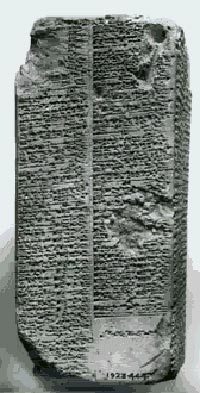

![]() The
ancient Egyptians documented the reigns of most of their kings on what is known
as today as the King List. It starts with Menes (the pharaoh who first united
Upper and Lower Egypt), and goes all the way to Cleopatra IV. The way it is
written is very linear and comprehensive, without spectacular and ficticious
beginnings. The dates are all quite accurate, and there is not much difference
in the dates on the kings list and those written inside the tombs. This allows
for cross-checking on other methods of record keeping, such as writings on pots.
The
ancient Egyptians documented the reigns of most of their kings on what is known
as today as the King List. It starts with Menes (the pharaoh who first united
Upper and Lower Egypt), and goes all the way to Cleopatra IV. The way it is
written is very linear and comprehensive, without spectacular and ficticious
beginnings. The dates are all quite accurate, and there is not much difference
in the dates on the kings list and those written inside the tombs. This allows
for cross-checking on other methods of record keeping, such as writings on pots.
 The
King List of Egypt is a way that we can date all other ancient civilizations,
because of its accuracy and consistancy. We are unable to use the King Lists
of other places like Sumeria, because of its numerous inaccuracies. For example,
on the Sumerian King List (part of the Sumerian King List is shown at left),
it begins with such myth, that nobody knows how long these kings actually reigned.
They have what is known as 'Before the Flood' and 'After the Flood'. 'Before
the Flood' consists of eight legendary and semi-divine rulers. (They lived 900,
or 180,000 years in some cases!) 'After the Flood' is more factual and less
based on myth. However, this fails to help us much because of the way dynasties
were set-up. They ran parallel to each other, meaning they all took place at
the same time. This is because the Sumerians, unlike the Egyptians, had what
are known as city-states. Therefore, it is possible to have many dynasties at
once, because there would be a dynasty for each city-state. So, you see, while
it might make for an interesting read, it is of little useage when it comes
to dating ancient history.
The
King List of Egypt is a way that we can date all other ancient civilizations,
because of its accuracy and consistancy. We are unable to use the King Lists
of other places like Sumeria, because of its numerous inaccuracies. For example,
on the Sumerian King List (part of the Sumerian King List is shown at left),
it begins with such myth, that nobody knows how long these kings actually reigned.
They have what is known as 'Before the Flood' and 'After the Flood'. 'Before
the Flood' consists of eight legendary and semi-divine rulers. (They lived 900,
or 180,000 years in some cases!) 'After the Flood' is more factual and less
based on myth. However, this fails to help us much because of the way dynasties
were set-up. They ran parallel to each other, meaning they all took place at
the same time. This is because the Sumerians, unlike the Egyptians, had what
are known as city-states. Therefore, it is possible to have many dynasties at
once, because there would be a dynasty for each city-state. So, you see, while
it might make for an interesting read, it is of little useage when it comes
to dating ancient history.
While the Egyptian King List is useful for dating history in general, it can be tricky when it comes to placing the beginnings and ends of dynasties. While one List might mark the 11th Dynasty as the end of the Old Kingdom, another will say that it is the beginning of the Middle Kingdom. This is due to the fact that things were recorded differently at different times in ancient Egyptian history. As an example, we can look at the conflicting dates of Mentuhotep II's rule. During, or at the end of his reign, he may have been recorded as the founder of the 11th Dynasty, and the beginning of the Middle Kingdom. Later on, however, he may have been looked upon as the last pharaoh of the 10th Dynasty, marking the very end of the Old Kingdom.
Egyptian Chronology - Explains the dating system and King List in more depth.
Turin King List - Perhaps the best-known of all the Egyptian King Lists. This site gives a good description and takes an in-depth look at it.
Tour Egypt's King List - A very complete list of kings put out by Tour Egypt.
